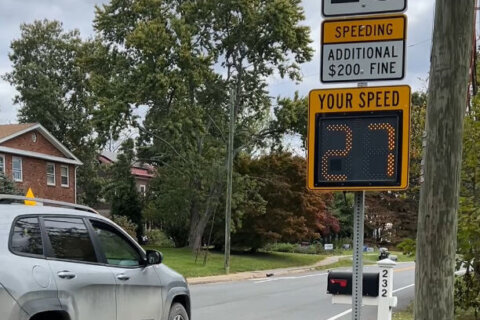This article was republished with permission from WTOP’s news partners at Maryland Matters. Sign up for Maryland Matters’ free email subscription today.
Maryland State Police Lt. David Ryan remembers every family notification he has delivered after a fatal highway accident.
“I can recount with photographic precision what the furniture looked like, what was on the walls, what was on the refrigerator, what everybody was wearing and what they said,” Ryan told local officials Friday. “And the emotion was powerful. Time stands still, and it happens right in front of the police officer.
“If I could capture that, that wave of human emotion, and share it with everybody, we wouldn’t be having this conference,” said Ryan, commander of the Maryland Department of State Police Traffic Incident Management Section.
“This conference” was a session on the state’s high number of roadway fatalities at the Maryland Association of Counties summer convention.
State and local officials Friday called for continued efforts to reduce highway fatalities in the state, which are on pace to exceed 550 this year.
There were 621 fatalities on Maryland roads and highways in 2023.
“Last year our fatalities were the highest number we’ve seen since 2007,” said Maryland Motor Vehicle Administration Administrator Chrissy Nizer. “It was really a tough year in terms of what we were seeing on the roadways.”
So far this year, 351 people have died on state roads and highways — a 6% decrease compared to the same time a year ago.
“We’re moving in the right direction, and that’s what we all strive for,” said Nizer.
But she cautioned that the underlying factors behind the high number of roadway deaths remain the same: speed, not wearing a seat belt, impairment, and distracted driving.
“This reckless, reckless behavior has devastating consequences, and that occurs all too frequently,” Ryan said. “The commonality of the excuses I’ve heard: I just want to get home, I was going with the flow … I didn’t realize my speed.
“I actually had somebody say, ‘I can’t drive 55.’ That’s true. He actually said that,” Ryan said.
If the state finishes the year with 6% fewer fatalities than 2023, it will still be more than the 566 who died in 2022.
Nizer avoids the word accident when talking about these deaths.
“What I always want to emphasize is that those common causes of crashes and fatalities are all choices,” she said. “You’re choosing to speed. You’re choosing to pick up your cellphone. You’re choosing to drink and get behind the wheel.”
Nizer said using the word “accident” minimizes the impact of deaths on surviving family members and ” it minimizes our ability to make a change.”
Nizer and others are calling for increased enforcement and public awareness, as the state presses to reduce the number of fatalities on roads in the state to zero by 2030 — a mandate set in state law.
Nizer said the law “is somewhat unique across the country, but it’s something that just shows how seriously our leaders, our elected leaders, feel about highway safety and reaching zero fatalities.”
“We always like to stress that it really is a multidisciplinary approach. It’s not a one-size solution, unfortunately, which is what makes it so complex and so difficult to try to get down to that goal of zero, but it is so important,” Nizer said.
A state law that took effect in June doubled the fine for speeding in highway work zones to $80. Those fines will increase again in January. The tiered penalties that go into effect raise the fines to as much as $1,000 based on factors including speed and the presence of workers.
Nizer said it’s too soon to attribute the decrease from last year to this year to any one factor. She said the drop may be a return to an already high level after a one-year spike.
“We focus on fatalities because of the finality. Clearly, it’s the most tragic job anyone can have,” Ryan said. “I’d also like everybody to think about the physical, mental injuries that can be life altering. Think about the inconveniences caused to everyone on the roadways. The massive delays. The missed opportunities.
“Thousands of Marylanders face this almost daily on one road or another,” he said. “All these people are just trying to get home.”







